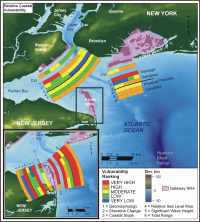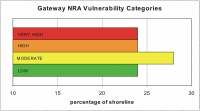Results
 |
| Figure 7. Relative Coastal Vulnerability for Gateway National Recreation Area. Click on figure for larger image. |
The calculated CVI values for Gateway range from 5.77 to 35.36. The mean CVI value is 14.80; the mode is 21.91 and the median 10.95. The standard deviation is 7.48. The 25th, 50th, and 75th percentiles are 8.5, 11.0, and 22.0, respectively.
Figure 7 shows a map of the CVI (vulnerability ranges) for Gateway National Recreation Area. The CVI scores are divided into low, moderate, high, and very high-vulnerability categories based on the quartile ranges. CVI values below 8.50 are assigned to the low vulnerability category. Values from 8.51-11.0 are considered moderate vulnerability. High-vulnerability values lie between 11.1 and 22.0. CVI values above 22.0 are classified as very high vulnerability. Figure 8
 |
| Figure 8. Percentage of Gateway shoreline in each vulnerability category. Click on figure for larger image. |
shows a histogram of the percentage of Gateway shoreline in each vulnerability category. Nearly 45 km (120 miles) of shoreline is evaluated along the Gateway NRA. Of this total, 24 percent of the mapped shoreline is classified as being at very high vulnerability due to future sea-level rise, all of which occurs at Sandy Hook, mostly on the seaward side. Another 24 percent is classified as high vulnerability, 28 percent as moderate vulnerability, and 24 percent as low vulnerability, almost all of which occurs along the Staten Island Unit from Ft. Wadsworth to Miller Field.




